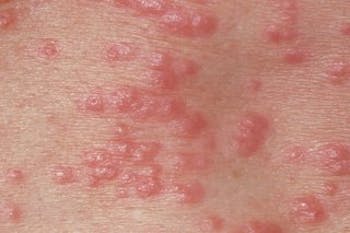Everything You Need to Know About Scabies
Reviewed and fact-checked by Alessandro Grenci, Superintendent Pharmacist. Read our editorial policy to see how we create informative, accurate content.
What is Scabies?
Scabies is a skin condition caused by tiny Sarcoptes scabiei mites. These mites burrow into the skin to lay eggs, causing an itchy rash.


Common symptoms include:
- Intense itching that worsens at night
- Burrow marks that appear as thin wavy lines ending in a dot
- Red pimple-like rash
- Sores caused by itching
Scabies is often found in the skin folds but can appear on many parts of the body.
In adults and older children, scabies is most often found:
- Between the fingers and toes
- In the armpits
- Around the waist
- Along the insides of the wrists
- On the inner elbows
- On the soles of the feet
- On the chest
- Around the nipples
- Around the belly button
- Around the genitals
- In the groin area
- On the buttocks
In severe cases, crusted scabies, also called Norwegian scabies, can form. Crusted scabies leads to thick, crusty skin and is usually seen on the elbows, knees, and feet.
Symptoms typically take 4 to 6 weeks to appear after initial exposure. In some cases, symptoms persist for months due to allergic reactions to mite debris, making early diagnosis and treatment essential. While anyone can get scabies, those in close contact are most at risk. This includes dorms, nursing homes, and crowded households.
Why is Scabies on the Rise?
The Royal College of General Practitioners (weekly report 42 2024) reports a 72% increase in cases compared to the average over the past five years. There were 3.1 cases per 100,000 people in the last week of October 2024.
The cause for this rise may be due to a variety of reasons such as medication shortages, lack of awareness surrounding the condition, social stigma, increased capacity in close quarters or reluctance to visit the doctor.
Dr Tess McPherson of the British Association of Dermatologists advised:
'While we don’t know for certain what is driving the number of cases up, this has been something we have been seeing for the last few years. Factors in the ongoing infestations seem to be delays in diagnosis, delays in beginning treatment, and not using treatments to full effect, which can lead to reinfection.'
How to Treat Scabies
Most scabies treatments kill mites within 24 hours, although symptoms like itching may take up to 4 weeks to fully resolve.
Treatments
At medino, we offer a range of over-the-counter creams to treat scabies. Our Superintendent Pharmacist Alessandro Grenci recommends the following:

Morningside Permethrin 5% Cream: Convenient 30g tube for effective relief.

Sandoz Permethrin 5% Cream: Fast-acting and easy to apply.

Lyclear Dermal Cream: Suitable for sensitive skin and children.

Derbac-M Liquid 0.5%: Gentle yet effective treatment for sensitive skin or when asthma is a problem.
Some treatments require a second application after 7 days to ensure all mites and eggs are eradicated.
Prevention
Preventing scabies spread is vital, especially in shared spaces. Follow these steps to stop scabies from spreading:
- Avoid close skin contact with infected people until treatment ends.
- Wash bedding and clothing at 60°C or higher to kill mites.
- Seal non-washable items in a plastic bag for at least 3 days—this both prevents spread and kills mites by depriving them of a host.
- Vacuum carpets and upholstery to remove any mites that might remain.
- Notify those you have been in close contact with (e.g., sexual partners or household members) so they can seek treatment.
Debunking Scabies Myths
Stigma around scabies stops many from seeking treatment and increases the risk of transmission.
Many people have either never heard of scabies or have only recently discovered what it is however the WHO reports that scabies affects over 200 million people globally. It is considered one of the most common dermatological conditions.
There is also a common misconception that scabies is extremely contagious - while there is truth to this, transmission requires prolonged skin contact, typically 20 minutes or more. It is highly unlikely that you will catch scabies by shaking hands or touching objects.
Like lice, there is the myth that poor hygiene causes scabies - this is not true. Anyone can get it, regardless of cleanliness. The reason it is advised to clean your bedding and clothing is because the mites and eggs can stay on your clothes for a short period which can cause reinfection.
Conclusion
Scabies can be uncomfortable but is treatable. Early treatment prevents further spread and reinfection. If you believe you may have scabies, consult a healthcare professional or pharmacist promptly. Don’t let stigma stop you from getting help—prompt treatment benefits everyone.
Sources:
- UKHSA guidance on the management of scabies cases and outbreaks in long-term care facilities and other closed settings
- Norfolk and Norwich University Hospitals NHS Foundation Trust: Trust Guideline for the Management of Scabies
- Scabies - NHS
- British Association of Dermatologists urging people to seek help for suspicious rashes
Created 22/11/24
